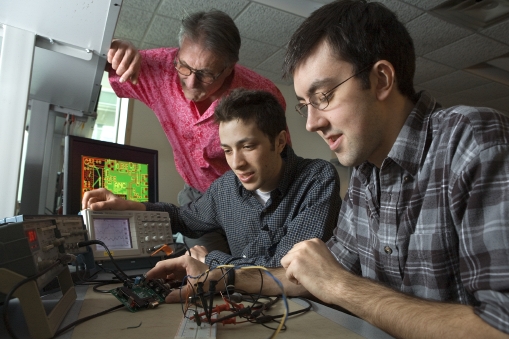COVER STORY SIDEBAR
When undergrad research gets out of the lab and into the marketplace
What's all the noise about undergraduate research?
In the case of seniors Robert Ochshorn and Kyle Wesson, a project they developed in engineering design class and then as an independent project has led to Cornell filing a provisional patent application based on the their adaptive noise-canceling technology. Ochshorn, a computer science major, and Wesson, electrical and computer engineering, developed a prototype in a five-week design lab, Digital Systems Design Using Microcontrollers (ECE 4760). Then in an independent research option the next semester -- with the support of their instructor, Bruce Land, a senior lecturer in electrical and computer engineering -- they turned the prototype into a product useful to researchers.

From left, senior lecturer Bruce Land, Robert Ochshorn '09 and Kyle Wesson '09 in the lab with their adaptive noise-canceling research project.
The invention is a low-cost method of canceling noise in electrical signals used to measure low-voltage processes (such as electrocardiogram measurements), in audio recordings from electrical instruments (like guitar "hum") or when using electronic systems near an AC transformer.
One way to remove this type of noise is to use digital signal processors or field programmable gate arrays, but they are far more expensive than Ochshorn and Wesson's solution, which uses a low-cost microcontroller to monitor the reference signal and output an out-of-phase signal to cancel the noise in analog.
The adaptive noise canceller could be used, as one example, to help neurobiology researchers make sensitive, noiseless measurements.
Using an adaptive filter for noise cancellation is a well-known, well-researched area, says Land. "The cleverness here is in how exactly it was implemented to make it inexpensive and high quality." Land notes that he often encourages his students to consider the intellectual property implications of their projects. "There are one, two or three every year that seem to me both interesting and unique. This one struck me in that way."
At Land's suggestion, Ochshorn and Wesson submitted a patent disclosure last fall to the Cornell Center for Technology Enterprise and Commercialization, which handles intellectual property and patent applications for Cornell-owned inventions. In January, they were notified that CCTEC had decided to file the provisional patent application based on their work.
Martin Teschl, CCTEC's technology commercialization and liaison officer, said that while it's not unusual for undergraduate research projects to result in invention disclosures, CCTEC rarely files a provisional patent application -- which gives Cornell a year to explore the marketable opportunities for the invention -- on student projects.
One reason is that nearly all undergraduate research that comes out of the labs or classrooms isn't actually owned by Cornell. "Under Cornell's inventions policy, Cornell only owns inventions made by its employees, and undergraduate students aren't considered employees," he says.
Cornell would only have ownership of a student invention or a claim to that intellectual property if research grants were used directly in the research, or if the students made what is called "substantial use" of Cornell facilities that wouldn't normally be available to them or that wouldn't be available to any other student in the class.
Ochshorn and Wesson, however, agreed to be treated as Cornell inventors, thus giving the university ownership. The benefit to the students "is that Cornell pays for the patent [application]," Teschl says, "and, through CCTEC, provides professional services related to our efforts in protecting and commercializing the invention."
For the students, the rewards are more in the research than the product. "One of the best parts of the whole experience has been getting to apply the theory we're taught in class," says Wesson.